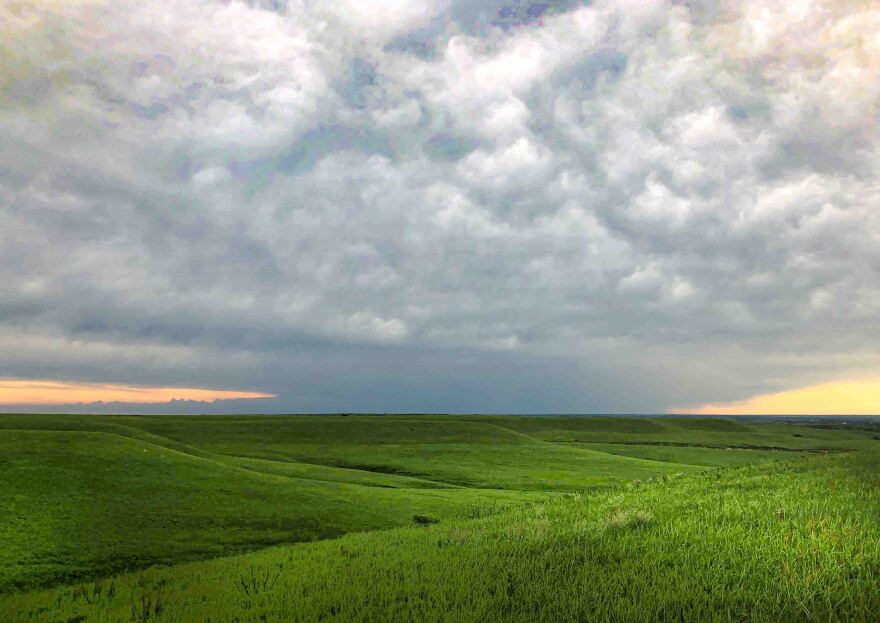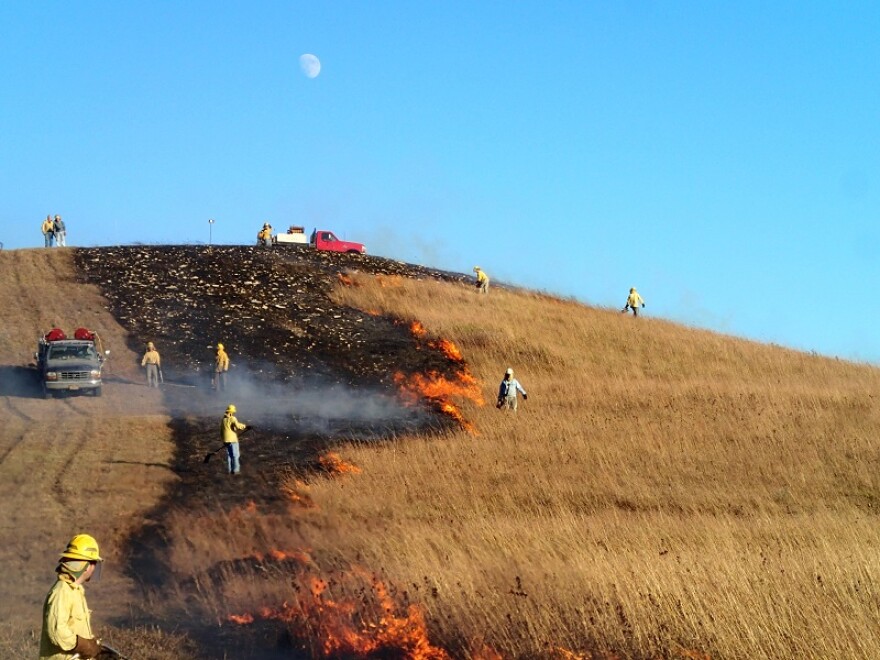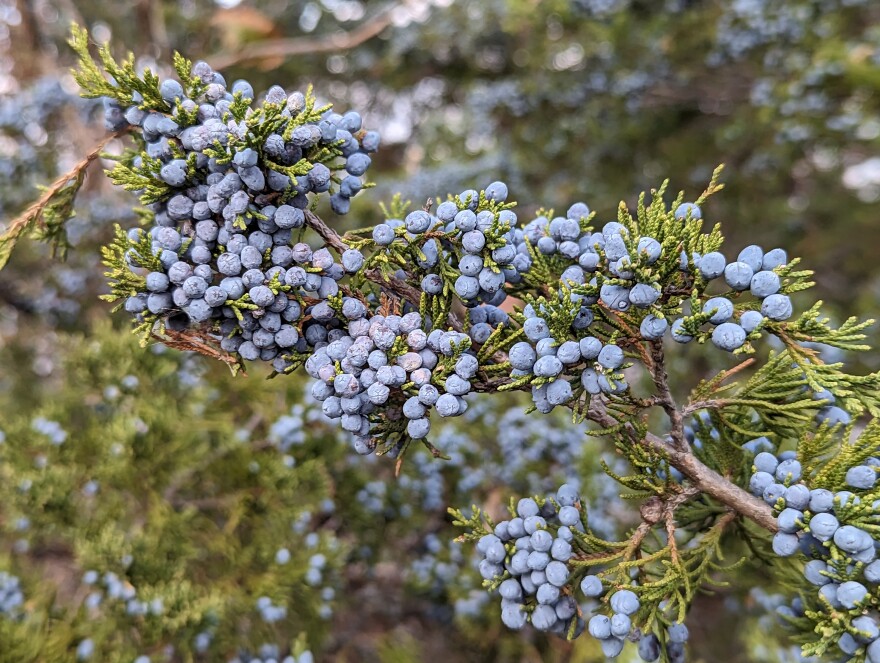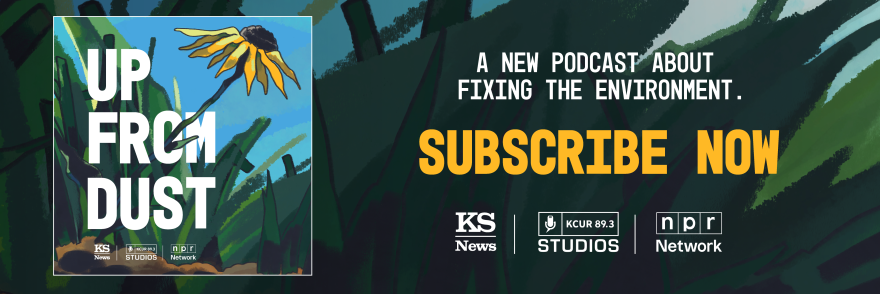STRONG CITY, Kansas — Flint Hills rancher Daniel Mushrush estimates that his family has killed maybe 10,000 trees in the past three years.
It’s a start. But many more trees still need to fall for the Mushrushes to save this 15,000 acres of rare tallgrass prairie.
Whenever other work on the property can wait, Daniel and his brother, Chris, don helmets and earplugs, grab their tools and pick up where they left off.
“It’s a lot of old-fashioned chainsaw work,” Daniel Mushrush said. “Walking rocky ridges and cutting down trees.”
The Mushrush family is beating back a juggernaut unleashed by humans — a Green Glacier of trees and shrubs grinding slowly across the Great Plains and burying some of the most threatened habitat on the planet.
This blanket of shrublands and dense juniper woods gobbling up grassland leads to wildfires with towering flames that dwarf those generated in prairie fires.
It also eats into ranchers’ livelihoods. It smothers habitat for grassland birds, prairie fish and other critters that evolved for a world that’s disappearing. It dries up streams and creeks. New research even finds that, across much of the Great Plains, the advent of trees actually makes climate change worse.
Now a federal initiative equips landowners like Mushrush with the latest science and strategies for saving rangeland, and money to help with the work.

Satellite imagery and a better understanding of how trees and shrubs spread could help landowners replace a losing game of whack-a-mole with a more systematic course.
Mushrush calls the approach, promoted by the Natural Resources Conservation Service’s Great Plains Grassland Initiative with guidance from the University of Nebraska-Lincoln, a morale builder.
“It works,” the third-generation rancher said. “We’re still overwhelmed with how to do this on 15,000 acres — but we have a plan.”
Each time he thinks about the Manhattan area, which is much more infested with juniper woods and seas of sumac, wild plum and dogwood thickets, he feels the threat creeping toward his home in Chase County.
“If a coral reef is worth saving, if some pristine mountain stream is worth saving, then so are the Flint Hills,” he said. “It’s not easy work, but it’s worthy work.”
Until recently, it seemed the iconic tallgrass landscapes of Chase County couldn’t possibly suffer the same fate as those around Manhattan. But satellite imagery of the Green Glacier’s expansion proved this is untrue.
“We realized we weren’t immune to it,” he said. “It was coming."

A disappearing world
An image of the Great Plains lingers in cultural consciousness: A place of vast, largely treeless horizons.
Grassland once covered one-third of North America.
Today’s precious, remaining regions of relatively intact prairie — places that somehow survived becoming cornfields and suburbs — now face steep odds.
“It is disappearing right in front of our eyes,” said Jesse Nippert, a professor and grassland ecologist at Kansas State University. “It’s happening everywhere on the planet.”
The phenomenon transforming grassland worldwide is called woody encroachment.
In North America, scientists at Oklahoma State University came up with the term “Green Glacier,” painting the image of a blanket of woody plants unfurling gradually but devastatingly across the center of the continent.
Even the Flint Hills have proven vulnerable, despite so many ranchers there conducting controlled burns for decades.

The threat is well known among ranchers, but even Midwesterners who rarely visit rangeland can likely spot the signs of change close to their homes.
Just look for the evergreens: Eastern red cedars are a juniper species with a misleading moniker.
The often rust-tinged conifers flank Interstate 70 and invade underused pastures and abandoned lots on the edges of towns and cities. They create dense woods and borders that swaddle semi-rural housing developments, ranchettes and hobby farms.
Long beloved and still frequently planted for the shelter they provide against wind and snow, the species is doubtlessly the most controversial tree in the region, sometimes causing frustration among neighbors.
If you’ve bought a slice of rural heaven to enjoy deer hunting or escape suburban life and the eyes of neighbors, you may well prize eastern red cedars.
If you’re a rancher, you likely hate them.
The trees are the single most prominent symbol of woody encroachment in the center of North America.
They’re spoiling grassland particularly fast in parts of Kansas, Nebraska, Oklahoma, Iowa, Missouri and South Dakota. The University of Nebraska-Lincoln launched a public education campaign devoted to sounding an alarm about the species.

To prairie conservationists, an eastern red cedar has one redeeming quality: It dies if you chop it down or set it on fire.
Other headache plants, such as American plum and rough-leaf dogwood bushes, don’t surrender so easily.
K-State scientists study every imaginable aspect of woody encroachment at the Konza Prairie Biological Station outside Manhattan.
They tried restoring infested tallgrass prairie by burning it 23 years in a row.
“Those shrubs are still everywhere,” Nippert said. “In fact, they expanded.”
That makes shrubs the single biggest danger to the Flint Hills, he said. Uninfested land must be burned every other year to keep them out.
After shrubs establish themselves, they become nearly unstoppable without spot-spraying herbicides.

Where did the Green Glacier come from?
The Green Glacier has edged out billions of pounds of grass in the United States. To ranchers, that’s a production loss. The land feeds fewer cattle.
To communicate the scale and speed of that loss, rangeland ecology professor Dirac Twidwell at the University of Nebraska-Lincoln compares the Flint Hills as it looked in the 1990s versus today.
The Flint Hills could grow about a billion more pounds of grass annually if it weren’t for how many trees and shrubs have taken root since then, he explained in an overview of the situation for Kansas landowners.
Picture all that grass rolled into giant, round hay bales.
“You could line those up side by side from Kansas City, Missouri,” he said, “and drive 9 hours seeing nothing but round bales all the way to Denver.”
Yet the sumacs, elms, plums, junipers and other woody plants spreading today have existed in the center of the continent for ages. They are mostly native species with their own ecological contributions.
What spurred them to proliferate so dramatically that they now threaten prairie flora and fauna, leading Twidwell and other scientists to conclude the grassland biome is collapsing?

The story of the Green Glacier unfolded over the past few centuries.
Humans have shaped North American ecosystems for millennia. And for a very long time, their way of managing the land helped foster the continent’s vast grasslands and prairie animals — primarily through the use of fire that kept trees at bay and made for excellent hunting.
More recently, humans began tipping the scales in favor of shrubs and trees.
It started after the arrival of Europeans and, ultimately, the U.S. government actions that decimated Indigenous populations and forced them from nearly all of their territory.
That simultaneously eliminated fire-based land management from much of the continent’s grasslands. The newcomers also eventually eliminated elk — massive, shrub-eating browsers — from much of their range.
Settlers came from countries and regions without vast grasslands. They valued trees over prairies and planted them at sometimes mind-bogglingly large scales.
Trees blocked wind, provided wood for construction and made the plains more hospitable to their ways of life.
In 1872, Nebraskans planted a million trees in a single day, the origin of Arbor Day. A few decades later, people there created what is today the biggest hand-planted forest in the Western Hemisphere.

Later, overfarming, drought and heat triggered the 1930s Dust Bowl.
The federal government, which had already encouraged and incentivized settlers to plant trees and hedgerows, sped up the work to protect soil and crops.
Meanwhile, humans had also industrialized the economy. Churning ever more carbon dioxide into the atmosphere spurred shrubs and trees to outcompete grasses.
“It’s more than a key contributor,” Nippert said of the role that increased CO2 plays in woody encroachment. “It’s probably the main reason.”
A new federal strategy to curb the Green Glacier
The federal government has over the years poured many millions of dollars into tackling woody encroachment piecemeal.
Landowners would restore what effectively amounted to scattered patches of grassland already thoroughly invaded or surrounded by trees.
“We just have more and more and more sites to treat over time,” Twidwell said. “We just don’t have the money and expenditures to continue that game plan. That experiment failed.”
Trying to save pasture in such steep decline requires the most expensive methods: Heavy machinery, long hours and herbicide by the barrelful. But in many areas, bulldozing trees and shrubs offers only temporary gains at best.

The seeds of the woody plants lay on the ground, ready to sprout a new generation. Birds swoop in with even more seeds from adjacent land.
The new approach is called “defending the core.”
Twidwell and his colleagues urge landowners to start their work in the healthiest grassland they have available — ideally areas with few to no woody plants. Next, work outward. Kill trees and shrubs along the way to create an ever wider expanse of contiguous, cleaned-up prairie.
Studies of eastern red cedars reveal a basic fact about how they spread: 95% of the time, their seeds sprout within a distance of two football fields.
In other words, American robins and other critters with a taste for juniper berries don’t travel all that far between feasting in a juniper tree and pooping out the seeds.
That’s good news to Twidwell.
“We can manage football fields,” he said.
By clearing an area and expanding outward, landowners can increase the acreage that is at least two football fields away from the nearest trees.

Ultimately, the zone becomes easier to protect with controlled burns. Prescribed fire is cheaper and safer than heavy machinery and chainsaws.
The Natural Resources Conservation Service — part of the U.S. Department of Agriculture — has thrown its weight behind the new approach.
It launched the Great Plains Grassland Initiative to help ranchers ramp it up in Kansas, Nebraska, Oklahoma and South Dakota.
By the end of this fiscal year, the program will help protect nearly 220,000 acres of grassland in Kansas alone, providing financial help and technical expertise to landowners.
The initiative homes in on relatively intact prairie regions where ranchers want to stop the Green Glacier and where progress could pay big dividends for the wildlife.
In Kansas, that means focusing on the Flint Hills, the Gypsum Hills, the Smoky Hills and certain other areas. Those ranching strongholds fuel America’s beef industry and support hundreds of species of plants and animals.
The Rangeland Analysis Platform, a tool created by the University of Montana and the U.S. Department of Agriculture, provides detailed satellite imagery that shows ranchers where woody plants have spread over the years.
That spells out their losses and helps them strategize.

The Green Glacier and wildfires
Fires happen.
When not enough controlled burns take place, wildfires become more severe.
When they strike rural areas and suburbs packed with drought-stressed eastern red cedars that contain volatile oils, the flames can travel quickly from the ground into tree crowns and onto rooftops.
One fire captain in Hutchinson described the trees as Roman candles spewing embers that can hitchhike on wind and land a quarter mile away, starting more blazes.
Juniper woods can produce 90-foot-tall flames, compared to flames under 15 feet in a grassland wildfire, University of Nebraska-Lincoln scientists say.
In March 2022, wildfire struck more than 6,000 acres near Hutchinson, killing one person and destroying more than 100 buildings, including 36 homes.
The juniper trees crowding the area made it hard to stop the flames, a state task force on wildfire concluded.

Gov. Laura Kelly created the task force in 2022. Extreme wildfires have become impossible to ignore.
Red cedars played the same amplifying role in the state’s two biggest recorded blazes, both of which struck within the past decade.
The Anderson Creek fire burned nearly 400,000 acres in Kansas and Oklahoma. A year later, 2 million acres of Kansas, Oklahoma and Texas burned in the Starbuck fire and other blazes at the same time.
The amount of land that burns each year in major wildfires on the Great Plains increased fivefold in the last 30 years, University of Nebraska researchers found.
Water on the prairie
Those are the kind of uncontrollable fires that the Mushrush family wants to avoid — yet another reason to slow the Green Glacier’s march into Chase County.
Likewise, they want to save precious creeks and streams at risk of disappearing.

Trees and shrubs use three times as much water as tallgrass does, Nippert from K-State says. Even worse, their thick roots drill holes that irreparably change how rainwater flows.
As they shatter the Flint Hills’ famously rocky ground, rainwater pounding the prairie sinks deep into the earth instead of traversing it and funneling into creeks and streams. Water disappears beyond the reach of both wildlife and livestock.
At the Konza research station, K-State scientists have watched streams get drier even as precipitation increased.
In 2010, they removed trees from a long swatch of watershed to see if they could restore flow. It didn’t work.
Last year brought the Mushrush ranch in Chase County its worst drought in a decade.
The family took heart when a creek that had dried up in the 2012 drought kept flowing where they had removed trees.

“Seeing the water flow through a stream,” he said, “You can see the results and go, ‘Hey, we did good.’”
Nippert, at K-State, fears much of the Flint Hills is now so fractured from tree and shrub roots that this kind of intervention won’t help.
“Mushrush and the people in Chase County are lucky,” Nippert said. “Do what you have to do to keep it the way that it is — before it transitions.”
Celia Llopis-Jepsen is the environment reporter for the Kansas News Service. You can follow her on Twitter @celia_LJ or email her at celia (at) kcur (dot) org.
The Kansas News Service is a collaboration of KCUR, Kansas Public Radio, KMUW and High Plains Public Radio focused on health, the social determinants of health and their connection to public policy.
Kansas News Service stories and photos may be republished by news media at no cost with proper attribution and a link to ksnewsservice.org.




